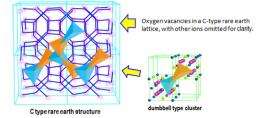First elucidation of cause of long-term stability deterioration in solid oxide fuel cells

NIMS and the University of Queensland Centre for Microscopy and Microanalysis, the Dalian Polytechnic University, and the Dalian Institute of Chemical Physics, Chinese Academy of Science, clarified for the first time the cluster structure which has an extremely large effect on the long-term stability of solid oxide fuel cells (SOFC) for independent distributed power generation.
Dr. Toshiyuki Mori, Group Leader of the Hetero-interface Design Group, Battery and Fuel Cell Field, Global Research Center for Environment and Energy Based on Materials Science (GREEN), National Institute for Materials Science (Japan), and Dr. Zhipeng Li, a Postdoctoral Researcher at GREEN, in joint research with Prof. John Drennan of the University of Queensland Centre for Microscopy and Microanalysis (Australia), the Dalian Polytechnic University (China), and the Dalian Institute of Chemical Physics, Chinese Academy of Science (China), clarified for the first time the cluster structure which has an extremely large effect on the long-term stability of solid oxide fuel cells (SOFC) for independent distributed power generation. This result was achieved by transmission electron microscope (TEM) observation and computer simulation based on the results thereof.
Active development of fuel cells for home use and large-scale generating systems using SOFC has been underway up to the present. However, while it was possible to manufacture devices which sufficiently satisfied performance requirements, elements of instability remained from the viewpoints of reliability and life, and these were major obstacles to practical application.
In this experiment, the nanoscale defect structures of high performance specimens and specimens which exhibited serious deterioration in performance were observed using a high resolution transmission electron microscope (TEM), and their distinctive features were then analyzed in computer simulations. This research ascertained for the first time that a “new oxygen defect cluster structure” which has a structure different from the “oxygen defect (oxygen vacancy) cluster structure” long considered to be the cause of reduced performance, forms in the material, triggering a phase transition, and this has a negative impact on the reliability and durability of fuel cells.
Various puzzling phenomena in SOFC, had been un-explained until now. These are (1) reason why a crystal phase transition occurs together with performance deterioration, (2) reason why adequate reliability cannot be maintained, etc., and they can be interpreted rationally using a model of this oxygen defect cluster structure. As a result effective solutions to these problems can be proposed based on materials science, and the development of high performance, high reliability, long life SOFC materials for use in independent distributed generation is expected to become possible.
These research results were published online on November 7 in “Rapid communications” in the journal of the American Institute of Physics, Physical Review B.
Journal information: Physical Review B
Provided by National Institute for Materials Science



















